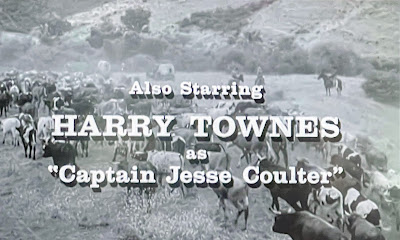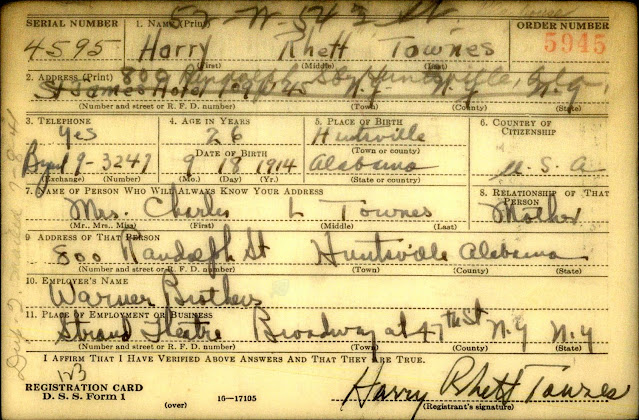I've written a number of posts on this blog about Alabama natives who have found success in Hollywood, ranging from actresses before 1960 such as Dorothy Sebastian and Gail Patrick to more recent individuals such as Gail Strickland and two who also graduated from my high school, Kim Dickens and Ned Vaughn. Now comes Harry Townes, Huntsville native, prolific television actor and Episcopal priest.
Harry Rhett Townes was born in Huntsville on September 18, 1914. I found him and his family in the 1920 U.S. Census via Ancestry.com At that time they rented a home on Eustus Street [probably Eustis Avenue near Maple Hill Cemetery; mistakes by census enumerators were common]. Harry was the younger son of Charles and Jeanne Townes; his brother was Halsey. Sister Jena was three years younger than Harry, who was listed as five at the time of the census. In the 1930 census when Harry was 15, the family lived at 809 Randolph Street. Father Charles is not listed; he had died on November 23, 1922 and is buried in Maple Hill Cemetery in Huntsville.
Presumably he graduated from high school in Huntsville, although I've yet to determine which one. Recent discussion about Townes on the Facebook "Huntsville Revisited" board indicated he went to Huntsville High. He spent time at the University of Alabama, where he may have caught the acting bug. Townes did not graduate; he's not listed in the UA directory of alumni anyway. He next appears in New York City, where he studied acting at Columbia University. I've run across one source that says he graduated there, but have yet to confirm it. His draft card, included below, puts him in New York in October, 1940.
He picked up some Broadway credits before enlisting in the U.S. Army Air Corps, in which he served from 1942 until 1946. After his service, Townes returned to New York to act, picking up more stage work and making his first forays into television.
As noted in the next paragraph, Townes' first tv credit was a Dumont program; the network broadcast from New York. Townes played the character of Peter Postman from 1949 until 1951. He also acted in episodes of two other programs from New York, Trapped and Robert Montgomery Presents. During this same period, 1950-1953, he also began acting in programs broadcast from Hollywood.
The first television credit listed for Townes at the IMDB is The Magic Cottage, a program on the Dumont TV network from 1949 until 1952. His final appearance came on the series Valerie in 1988. Between those dates he acted in episodes on dozens of shows, many multiple times. These included Perry Mason (5), Rawhide (4), Route 66 (3), Twilight Zone (2), Playhouse 90 (3), Studio One (12), Climax! (9), Kraft Theatre (15), Armstrong Circle Theatre (10), Ponds Theater (6), Gunsmoke (7) and The Fugitive (5). He played four different doctors in that many episodes of Quincy, M.E. Townes made single appearances on such programs as Ben Casey, The Outer Limits, The Virginian, Branded, Star Trek, The Big Valley, Mod Squad, Marcus Welby, M.D., Lou Grant, and Magnum, P.I. Whew! And all of these listed only scratch the surface of his tv credits.
Townes acted in more than 200 television programs, but he also appeared in several films. These include Operation Manhunt [see more on this one below], The Mountain, The Brothers Karamazov, Cry Tough, Sanctuary, The Bedford Incident, In Enemy County and The Hawaiians.
While in his thirties his sister Jeanne was diagnosed with terminal cancer. Following a vision she had, her disease went into remission. This event prompted Townes' own spiritual journey that eventually led him to the priesthood. He continued acting but put himself through theology school in Los Angeles. In 1973 at age 59 and following ten years of study he became a transitional Episcopal deacon and then was ordained Father Harry Townes at St. Paul's Cathedral in Los Angeles on March 16, 1974. He had several non-stipend assignments in that city, Hollywood and Palm Springs as he continued to earn his living with film and television work.
Townes retired from acting in 1988, and returned to Huntsville. According to city phone books available via Ancestry.com, he lived on Randolph Avenue near a childhood home in the mid-1990s and on Mountain Brook Drive SE from 1998 until his death on May 23, 2001. He apparently never married. Townes outlived the other members of his family. Mother Jeanne died in 1967 and is buried in Maple Hill. Sister Jean died in 1998 and is also buried in Maple Hill. Older brother Milton died in 1978 and was interred in Elmwood Cemetery in Birmingham.












































